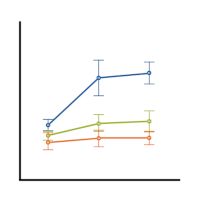Whenever I get email questions whose answers I think would benefit others, I like to answer them here. I leave out the asker’s name for privacy, but this is a great question about dummy coding:
First of all, thanks for all those helpful information you provided! Thanks sincerely for all your efforts!
Actually I am here to ask a technical question. See, I have 6 locations (let’s say A, B, C, D, E, and F), and I want to see the location effect on the outcome using OLS models.
I know that if I included 5 dummy location variables (6 locations in total, with A as the reference group) in 1 block of the regression analysis, the result would be based on the comparison with the reference location.
Then what if I put 6 dummies (for example, the 1st dummy would be “1” for A location, and “0” for otherwise) in 1 block? Will it be a bug? If not, how to interpret the result?
Thanks a lot!
Great question!
If you put in a 6th dummy code for Location A, your reference group, the model will actually blow up. (Yes, that’s a technical term).
This is one of those cases of pure multicollinearity, and the model can’t be estimated uniquely.
It’s the same situation you learned back in Algebra where you have two equations, one unknown. The problem isn’t that it can’t be solved–the problem is there are an infinite number of equally good solutions.
If an observation falls in Location A, the reference group, we’ve already gotten that information from the other 5 dummy variables. That observation would have a 0 on all of them. So we already know it’s location is A. We don’t need another dummy variable to tell the model that. It’s redundant information. And so perfectly redundant that the model will choke.
Dummy coding is one of the topics I get the most questions about. It can get especially tricky to interpret when the dummy variables are also used in interactions, so I’ve created some resources that really dig in deeply.
 While there are a number of distributional assumptions in regression models, one distribution that has no assumptions is that of any predictor (i.e. independent) variables.
While there are a number of distributional assumptions in regression models, one distribution that has no assumptions is that of any predictor (i.e. independent) variables.
It’s because regression models are directional. In a correlation, there is no direction–Y and X are interchangeable. If you switched them, you’d get the same correlation coefficient.
But regression is inherently a model about the outcome variable. What predicts its value and how well? The nature of how predictors relate to it (more…)
Oh so many years ago I had my first insight into just how ridiculously confusing all the statistical terminology can be for novices.
I was TAing a two-semester applied statistics class for graduate students in biology. It started with basic hypothesis testing and went on through to multiple regression.
It was a cross-listed class, meaning there were a handful of courageous (or masochistic) undergrads in the class, and they were having trouble keeping (more…)
 In many research fields, a common practice is to categorize continuous predictor variables so they work in an ANOVA. This is often done with median splits. This is a way of splitting the sample into two categories: the “high” values above the median and the “low” values below the median.
In many research fields, a common practice is to categorize continuous predictor variables so they work in an ANOVA. This is often done with median splits. This is a way of splitting the sample into two categories: the “high” values above the median and the “low” values below the median.
Reasons Not to Categorize a Continuous Predictor
There are many reasons why this isn’t such a good idea: (more…)
To increase power:
- Increase alpha
- Conduct a one-tailed test
- Increase the effect size
- Decrease random error
- Increase sample size
Sound so simple, right? The reality is that although these 5 ways all work (more…)
 I was recently asked about whether it’s okay to treat a likert scale as continuous as a predictor in a regression model. Here’s my reply. In the question, the researcher asked about logistic regression, but the same answer applies to all regression models.
I was recently asked about whether it’s okay to treat a likert scale as continuous as a predictor in a regression model. Here’s my reply. In the question, the researcher asked about logistic regression, but the same answer applies to all regression models.
1. There is a difference between a likert scale item (a single 1-7 scale, eg.) and a full likert scale , which is composed of multiple items. If it is a full likert scale, with a combination of multiple items, go ahead and treat it as numerical. (more…)


